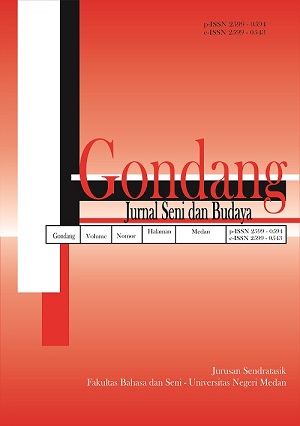Kajian Proporsi Wajah Wayang Potehi Perempuan di Gudo, Jombang dengan Proporsi Rasio Emas
DOI:
https://doi.org/10.24114/gondang.v5i1.21197Keywords:
Potehi Puppet, Face Proportion, Puppet, Golden Ratio, Indonesia Culture.Abstract
Since long time ago, people of the archipelago have interacted with various foreign nations and it led to the integration of local cultures and migrant cultures and resulting some new cultures. One of them is Potehi Puppet, a puppetry originated from China then developed in Java. The purpose of this study is to find out and describe a face proportion of female character of Potehi Puppet in Gudo, Jombang. The method that used is quantitative research by measuring some female characters of Potehi Puppet using Golden Proportion theory and calculate the mean of the measuring result also interview to the chairman, Toni and puppeteer of Hok Ho An (Potehi group in Gudo), Sonny and direct observation. Golden Proportion theory is not used to judge but used as tool to find out the mean of face proportion measuring. The result showed that there is an acculturation between Chinese and Javanese culture in visual, language, story, character and their characteristics and the artists behind Potehi Puppet. Potehi Puppet characters are distinguished majority by symbols on their clothes and accessories especially female characters. Some characteristics of female Potehi Puppet that Toni™s engravers made which quite different with female Potehi Puppet that made in China. It shows that artists background (Javanese) influences their Potehi Puppet work.References
Junaedi, D. (2017). Estetika Jalinan Subjek, Objek dan Nilai. ArtCiv.
Kaplan, D., & Manners, R. A. (2012). Teori Budaya. Pustaka Belajar.
Kuardhani, H. (2011). Toni Harsono Maecenas Potehi dari Gudo. Isac Book.
Kuardhani, H. (2018). Potehi Puppet (布袋戲) in Java. Dance & Theatre Review, 1(1). https://doi.org/10.24821/dtr.v1i1.2247
Kuardhani, H. (2019). Sehu: Dalang Wayang Potehi (布袋戲) di Jawa. Wayang Nusantara: Journal of Puppetry, 2(1), 1“10. https://doi.org/10.24821/wayang.v2i1.2996
Kuardhani, H., Soemanto, C. B., Simatupang, L. L., & Haryono, T. (2011). Legenda Penciptaan Teater Boneka Tiongkok di Persebarannya di Nusantara. Resital, 12(1), 1“13.
Kurniawan, I. D. G. A., Magdalena, R., & Susatio, E. (2015). PENGARUH GOLDEN RATIO PADA PROPORSI WAJAH TERHADAP PERSEPSI ESTETIKA WAJAH. E-Proceeding of Engineering, 2, 3047“3053.
Nurgiyanto, B. (2011). Wayang dan Pengembangan Karakter Bangsa. Jurnal Pendidikan Karakter, 1(1), 18“34.
Patriantoro, T. H. (2020). Fungsi dan Makna Desain Karakter Wayang Potehi Lakon Shi Jhin Kwie. In Panggung (Vol. 30, Issue 1). https://doi.org/10.26742/panggung.v30i1.728
Schwartz, S. J., Unger, J. B., Zamboanga, B. L., & Szaapocznik, J. (2010). Rethinking the Concept of Aculturation: Implications for Theory and Research. Am Psychol, 65(4), 237“251. https://www.ncbi.nlm.nih.gov/pmc/articles/PMC3700543/pdf/nihms481011.pdf
Shrestha, D. N., Khanal, D. A., & Wei, D. X. L. (2018). Assessment of Facial Golden Proportions in Chinese Adults in Hunan Province. Orthodontic Journal of Nepal, 8(1), 28“32.
Subiyantoro, S., Kristiani, & Wijaya, Y. S. (2020). Javanese Cultural Paradoxism: A Visual Semiotics Study on Wayang Purwa Characters of Satria and Raseksa Figure. Harmonia, 1, 19“28.
Suparno, A. (2017). Memaknai Kembali Tradisi Wayang Potehi. Litera, 16(2), 189“202.
Suwanto, Y. (2017). PELESTARIAN SENI PERTUNJUKAN WAYANG POTEHI DI JAWA TIMUR (东爪哇布袋æˆæ¼”出艺术的ä¿ç•™). Century, 5(1), 18“27.
Widyani, T., Tjaturrini, D., & Sutanto, F. (2017). Wayang Potehi : Makna Ragam Hias Hewan pada Dekorasi Panggung Pertunjukan. Parafrase, 17(02), 57“64.
Downloads
Published
How to Cite
Issue
Section
License
Copyright (c) 2021 Gondang: Jurnal Seni dan Budaya

This work is licensed under a Creative Commons Attribution 4.0 International License.

This work is licensed under a Creative Commons Attribution-NonCommercial-ShareAlike 4.0 International License.

